Coco Chanel's first Parisian boutique revolutionized women's fashion with its sleek, minimalist aesthetic. Soft lighting illuminates elegantly curved shelves displaying Chanel's signature styles – the Chanel suit with its boxy cardigan jacket, the little black dress cut for movement. These clothes freed women from restrictive garments to embrace simply cut, versatile pieces. Against a backdrop of 20s Deco opulence, the boutique ushered modernity into fashion.
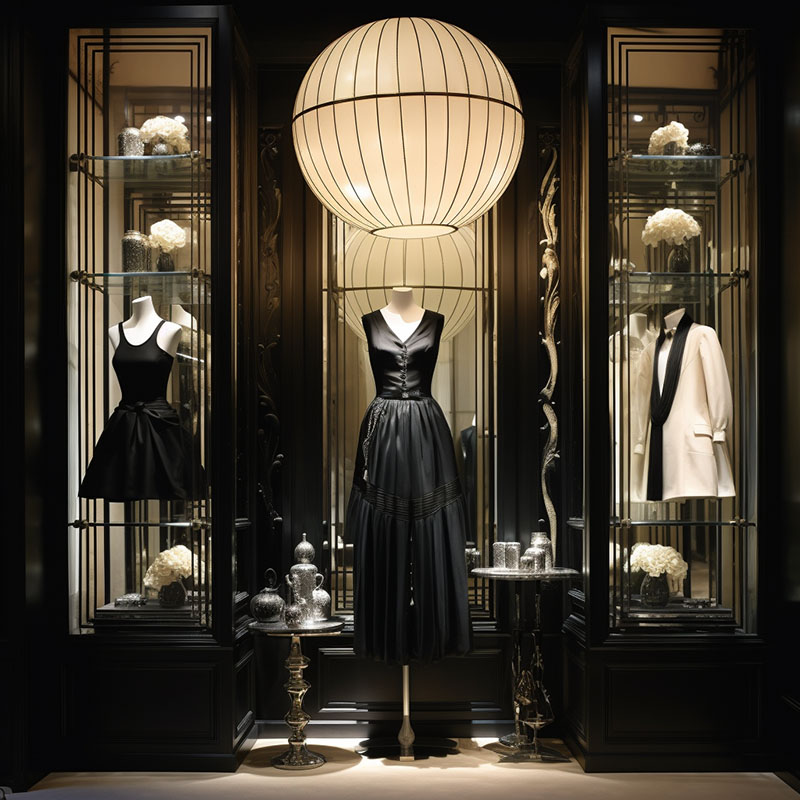
An icon of 20s Paris, Coco Chanel wears her own uniform: a boxy tweed jacket and skirt suit accented with strands of pearls. The Eiffel Tower frames her silhouette as a fitting attribute of the city she conquered with her fashion vision of effortless chic. Her cropped hair epitomized the 1920s garçonne look, reflecting her conviction that women deserved equal freedoms and comforts as men. In this artistic rendering, the essence of her bold, lasting influence is immortalized.
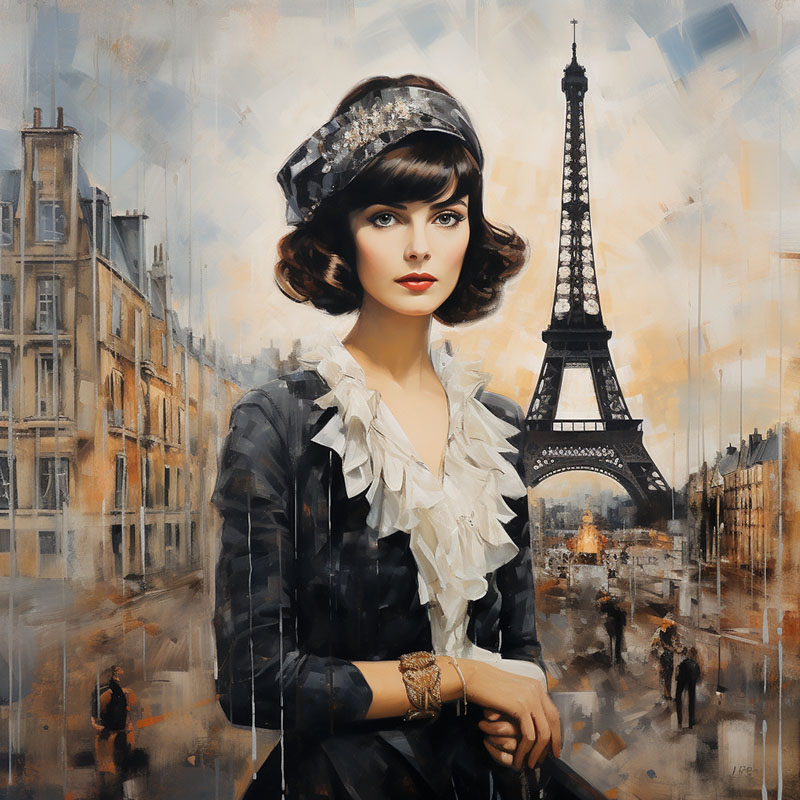
Coco surveys her burgeoning empire in her Rue Cambon studio, a couturier presiding over her realm. Sketches and swatches of fabrics litter the tables around her, the raw materials of inspiration waiting to be spun into gold. Nearby rests an early iteration of the Chanel N°5 perfume bottle, its sleek lines eerily echoing the iconic rectangle minaudières in her 1927 jewelry collection. The future of her now legendary house sits nascent amid the daily business of design.
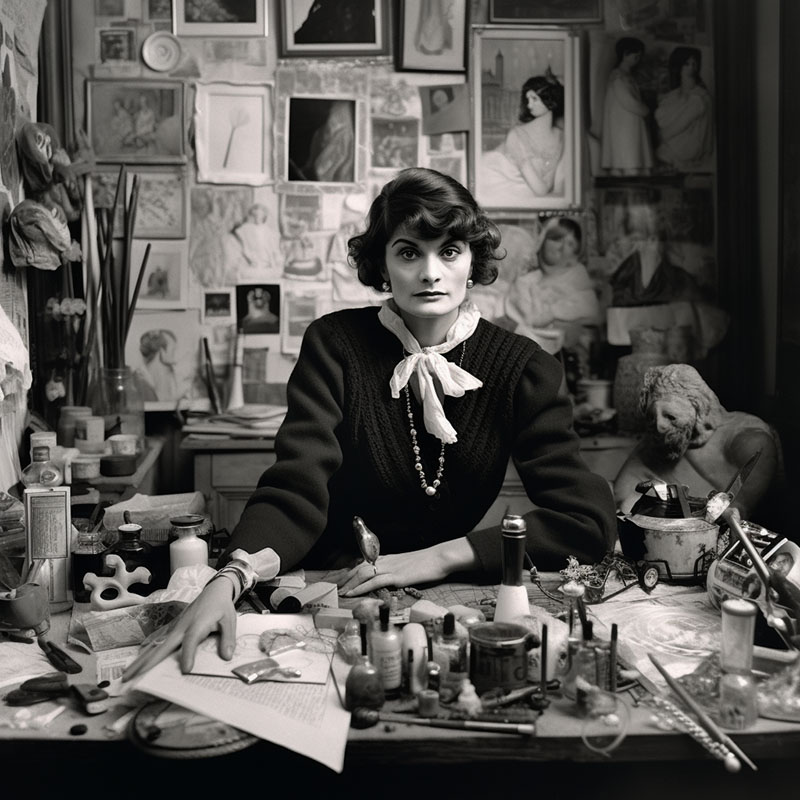
Chanel's 1925 collection debuted to instant acclaim, the talk of Paris from the moment models first stepped onto the catwalk. Unadorned dresses skim lithe forms, their fluid movement unleashed by dropped waists and unstructured cuts. Fringed shawls warm bare shoulders as ensembles morph from day to evening with elegant ease. Watching from the wings, Chanel witnesses the impact of her clothing philosophy rendered in chic silhouettes that redefined modern elegance and granted women greater freedom of movement.
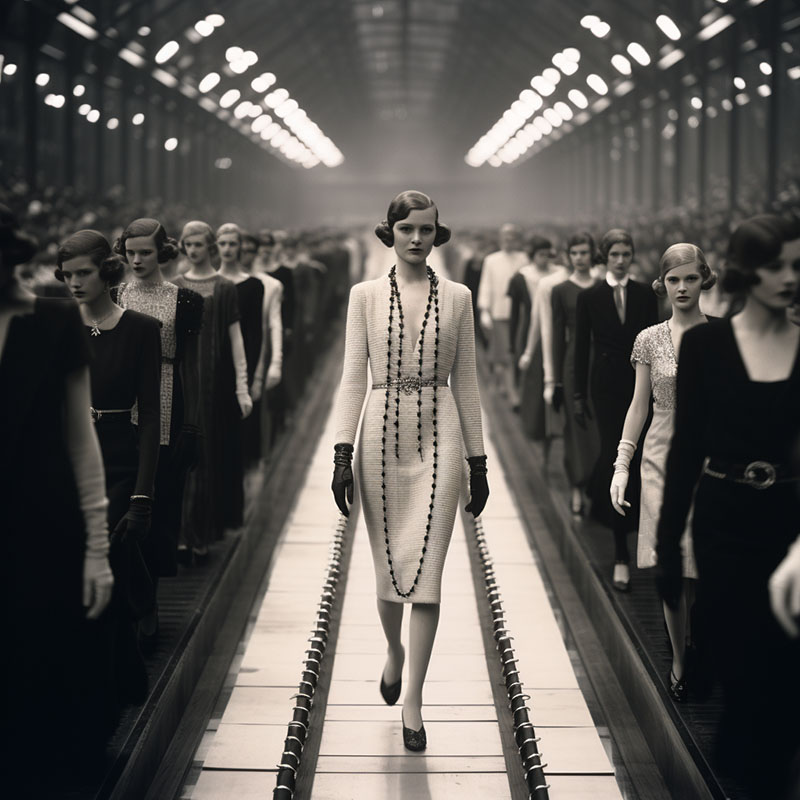
Pins line Chanel's mouth as she works, scattering straight pins over a form while draping and pinning fabric swaths into place. Inspiration collages and dress forms stand sentinel around her studio table. A tweed jacket takes shape under her practiced hand, echoing the one Coco herself wears in homage to her humble orphanage days. She delights in the alchemy of transforming thread into gold, spinning what women desire into reality with her scissors and sewing machine.
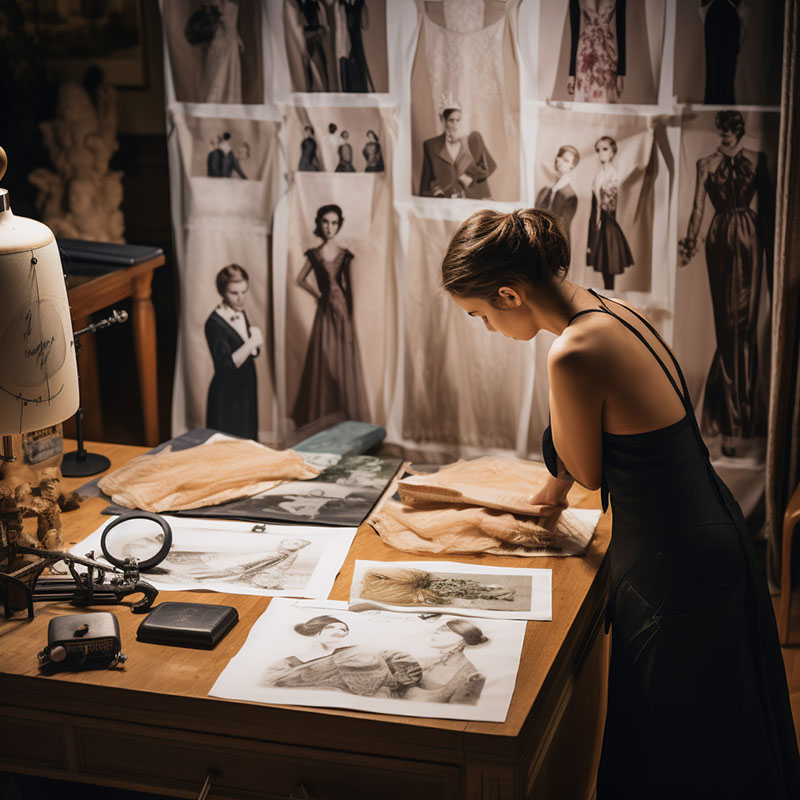
Chanel reigns over 1930 Parisian high society, her influence apparent in every sequined jacket, draped gown, and cocktail fringe at this fashionable gala. Having clawed her way to the apex of style, she surveys the crowd with satisfaction from her high seat. These elegant patrons now deem it an honor to don her creations and be seen in her signature No. 5 perfume. Under chandelier light, her fashions glitter as the height of luxury while giving women greater social access and mobility.
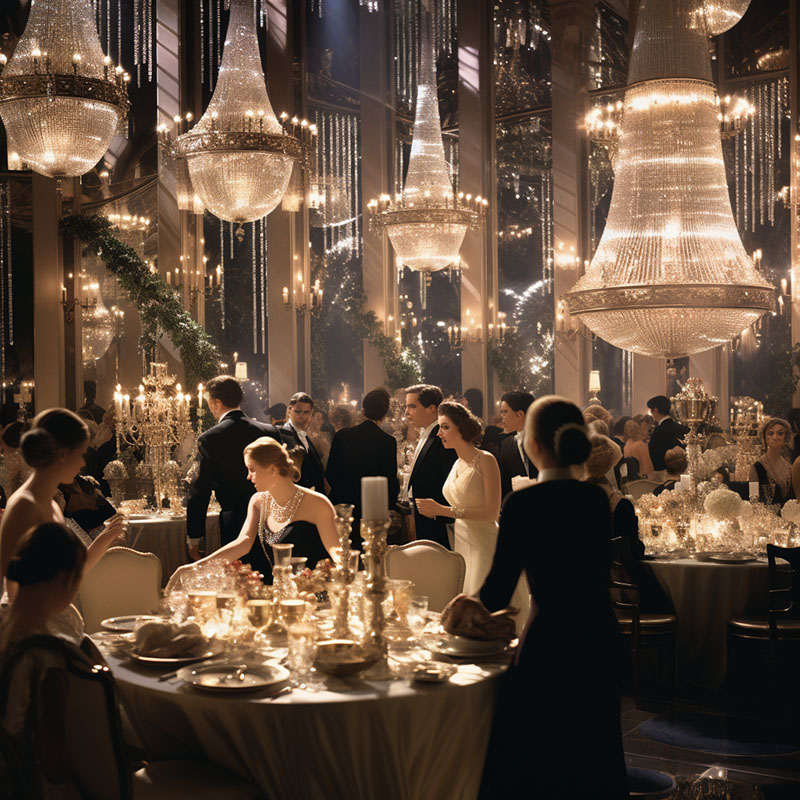
The clean lines of the Chanel N°5 bottle have varies little since Chanel tapped the chemist Ernest Beaux to create her debut fragrance in 1921. Against a Deco-inspired background, its unembellished rectangle form reflects her design dictum, “luxury must be comfortable, otherwise it is not luxury.” This bottle remains virtually unchanged from her vision 100 years ago. An enduring icon of the Chanel brand, it continues to channel her avant-garde influence to successive generations.
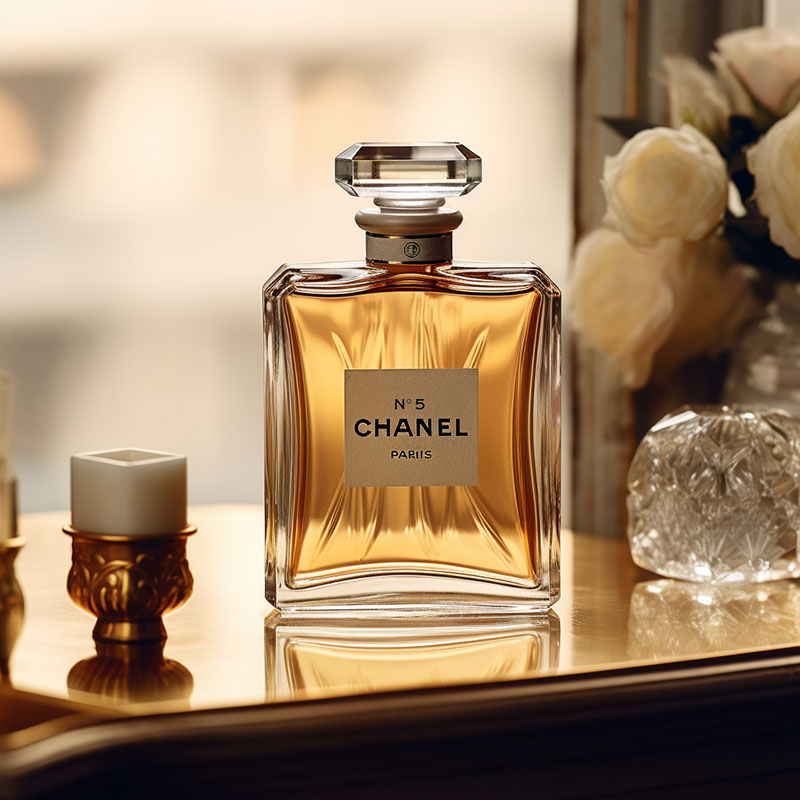
Coco Chanel indelibly revolutionized women's freedom and style in clothing. Her innovations collage into lasting icons – the cardigan suit jacket, the Little Black Dress, her graphic necklaces. Juxtaposed are images of modern women thriving in her simplified designs: an editor focused at her typewriter, a dancer leaping freely. Chanel liberated women's bodies and minds by stripping fashion down to its basics to empower generations forward. Her bold styles championed androgyny and strength in women's clothing form and function.
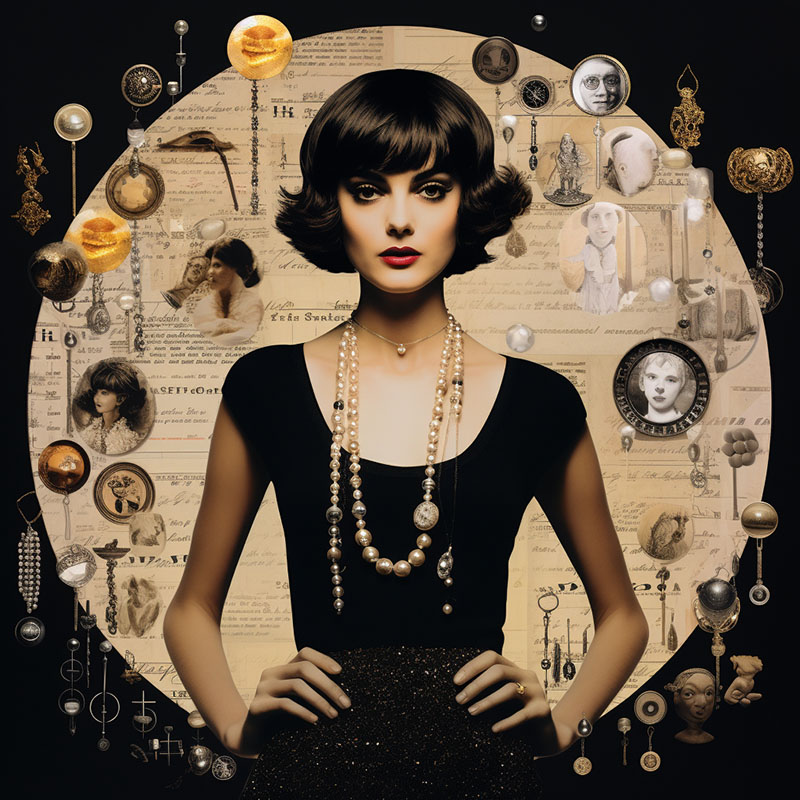
A Chanel haute couture studio brims with activity and expertise. Seamstresses lean intently over gowns, meticulously sewing Chantilly lace overlays and hand-setting Lavallière pleats into cascading trains. Apprentices master the perfect invisible stitch while seasoned embroiders transform fabric into high art with tiny knots. Skilled artisans tend this revered Parisian salon – fitting, cutting, draping and sewing one-of-a-kind creations as extravagant as the clients they will adorn. Yet even couture pays homage to Chanel's enduring mantra: luxury arises from exquisite construction, not mere ornamentation.
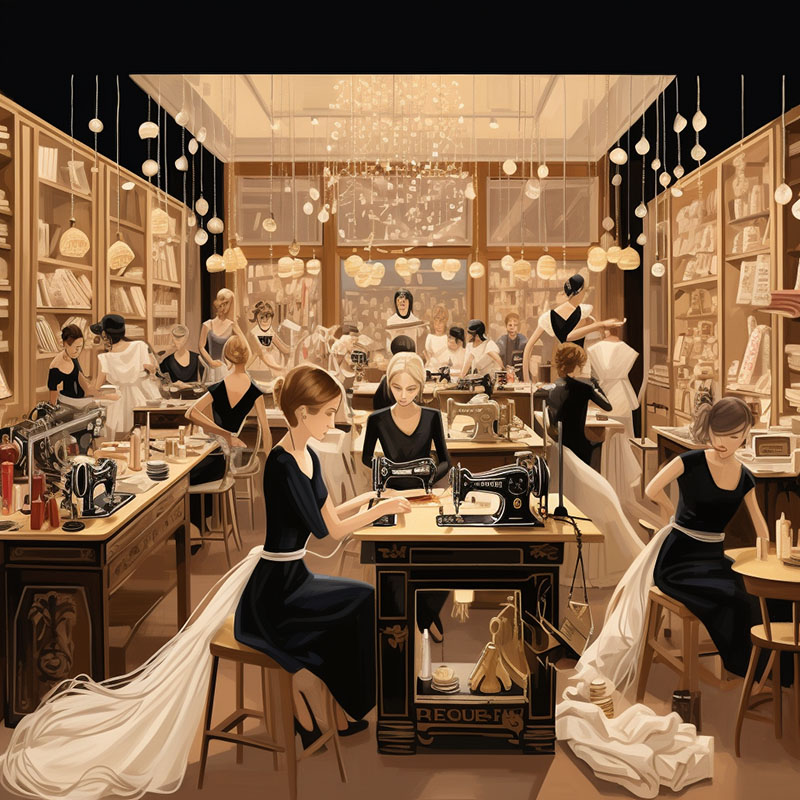
Coco Chanel, born Gabrielle Bonheur Chanel on August 19, 1883, was a pioneering French fashion designer whose modernist philosophy, menswear-inspired fashions, and pursuit of expensive simplicity made her an important figure in 20th-century fashion. Her influence extended beyond couture clothing; her design aesthetic was realized in jewelry, handbags, and fragrance. Her signature scent, Chanel No. 5, has become an iconic product.
Chanel was raised in an orphanage where she was taught to sew, a skill that would lead to her life's work. Her first shops, opened in 1910, were initially hatters before expanding to include clothes, with the Chanel suit and the little black dress becoming iconic products. These items were revolutionary in their time for being both functional and chic, freeing women from the constraints of corseted silhouettes.
Chanel revolutionized women's fashion by adapting men's styles into comfortable suits and evening pants for women, often featuring a crisp white collar, reminiscent of her convent upbringing. She enhanced her designs with faux jewels and pearls. As her fame grew, Chanel's social circle included celebrities like Igor Stravinsky and Princess Grace, all admirers of her luxurious yet comfortable clothing.
Chanel's emphasis on simplicity and elegance in her designs, her use of jersey fabric, and the introduction of trousers for women were just a few of her contributions that have had a lasting impact. She passed away on January 10, 1971, but her legacy continues, with the Chanel brand still at the forefront of high fashion.
Coffee Table Book
Amazon recommendation: Chanel: Her style and her life (paid link) combines large black-and-white photos of the designer, her clothes and jewelry, and her lavishly decorated homes with the story of her life. The result is a book that proves how closely Chanel's career and her personal life were intertwined--how her life played out in her style and how her style, ultimately, was the sum of Coco Chanel's life.
Fragrance: Chanel Coco Mademoiselle
Amazon recommendation: Coco Mademoiselle by Chanel for Women, Body Lotion, 6.8 Ounce (paid link)
 Supermodel Kate Moss stars in the Chanel Coco Mademoiselle ad campaign. In June 2002, Coco Mademoiselle became the first fragrance in history to win the prestigious FiFi award in every country in a single year.
Supermodel Kate Moss stars in the Chanel Coco Mademoiselle ad campaign. In June 2002, Coco Mademoiselle became the first fragrance in history to win the prestigious FiFi award in every country in a single year.
In an unprecedented evening, Coco Mademoiselle by Chanel capped off a year of gold medal performances at the 30th annual Fragrance Foundation FiFi awards, bringing home top honors for Best Women's Fragrance Introduction of the Year.
This win marks the sixth FiFi awarded that year to Coco Mademoiselle, which launched in April 2001, and the first time in history that a fragrance has won the FiFi in all countries in a single year. It was the Prestige Fragrance FiFi winner in France, Germany, Spain, Italy and Great Britain, and the European Star of the Year. The FiFi's are considered to be the "Oscars" of the fragrance industry. Winners are selected by the 1,000 members of the Fragrance Foundation as well as retailers and press. The U.S. FiFi's were hosted by Annette Green, president of the Fragrance Foundation, and Tommy Tune, Broadway choreographer and dancer. Celebrity presenters included Gene Simmons, Li'l Kim, Jamie Lynn Sigler, Debbie Gibson, Candace Bushnell, Carol Alt and Elaine Stritch.
"Bringing home the U.S. FiFi is the culmination of an incredible year for Coco Mademoiselle, and we could not be more excited," said Laurie Palma, senior vice president, fragrance and internet marketing. "There were a record number of fragrance launches last year, so to receive this recognition from our peers is truly an honor."
Coco Chanel Mademoiselle was created by Jacques Polge, Chanel master perfumer, who was challenged with the task of creating a fragrance that Mademoiselle Coco Chanel herself would wear if she were turning 21 in the 21st century. The result is this new original that combines a fresh oriental with a sparkling top note, rich spicy accents and warm, spicy musk.